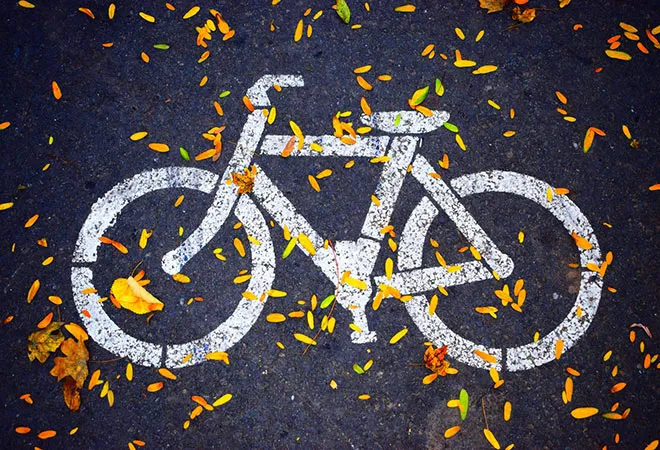-
CENTRES
Progammes & Centres
Location
Clearly determined traffic rules for cyclists, training and sensitising cyclists, motorists, pedestrians and law enforcement agencies — especially traffic police, to an increase in cyclists on the roads will help to minimise motor/pedestrian and cycle conflicts and ensure road safety for all involved.

Mumbai is all set to jumpstart a ‘cycling revolution’ for enthusiasts, with each of its 24 administrative wards having their ward-wise 'bicycle councillors’, led by a bicycle Mayor. With the WHO recommending cycling “both as a mode of transport and as a way of staying healthy throughout and after the global crisis,” this is a great initiative to ensure that the Covid-19 mobility response provides sustainable long term solutions to mobility problems in the city.
As several Indian cities and towns begin the process of unlocking post the Covid-19 restrictions, there is a focus on different forms of mobility to mitigate city transport problems. Non-motorised transport (NMT) options of personal mobility like walking and cycling are fast emerging as the preferred choice, as they provide a reliable and healthy access to places while still ensuring people maintain physical distance.
"More riders will ensure that there is public pressure to build better cycling infrastructure — and better cycling infrastructure would ensure more people are drawn to just pedal away on the cycling lane instead of sitting in their cars in a traffic jam."
The Mumbai concept, is a leaf borrowed from Amsterdam, the cycling capital of the world. A social enterprise founded in 2015 aims to make half of all city trips by bike by 2030 and works through its network of bicycle mayors and leaders in cities all over the world. There are currently 36 bicycle mayors in India. At different scales of urbanisation from tier 2 cities to million plus cities, all of the Indian bicycle mayors have two common aims — to increase the number of cyclists and to enhance cycling infrastructure in their cities.
The two seem to be a chicken and egg solution to decreasing pollution and congestion, and improving economic indicators, especially for last mile connectivity options. More riders will ensure that there is public pressure to build better cycling infrastructure — and better cycling infrastructure would ensure more people are drawn to just pedal away on the cycling lane instead of sitting in their cars in a traffic jam. According to a TERI study published in January 2019, switching to bicycles for short distance trips could result in an annual benefit of INR 1.8 trillion.
"The move to becoming a bike-friendly city, for Amsterdam and other cities like Delft, came after decades of activism and public rallying by all sections of the population."
However, India has a long way to go before Indian roads are termed ‘bike-tolerant,’ let alone being bike-friendly, which looks like a distant dream as of now. With the focus on road infrastructure projects, construction of expressway lanes and 10-lane highways in the last two decades, we have severely neglected the development of bike infrastructure in the country. In this respect, Indian roads look reminiscent of European roads in the 1960s, where several cities were fighting with rising road fatalities due to increased car and human collision. Bicyclists seemed to be obliterated from city roads. The move to becoming a bike-friendly city, for Amsterdam and other cities like Delft, came after decades of activism and public rallying by all sections of the population.
With Covid-19 and the resultant lockdowns, all that looks to change. It seems that India can bypass decades of activism — as public support for biking and government encouragement to increase NMT adoption comes at the same time as a response to enhance the post lockdown mobility experience. While there are several cities restarting, for most cities and towns with a high degree of coronavirus transmission risk, the actual number of people on streets is low. This translates into lower traffic and better conditions for cyclists to become ‘visible’ on city streets. The recent directives of the Ministry of Housing and Urban Affairs (MoHUA) to states, union territories and cities looking to restart transit operations focus on NMT as the priority mode to be adopted for trips under 5 km length.
"While there are several cities restarting, for most cities and towns with a high degree of coronavirus transmission risk, the actual number of people on streets is low."
One aspect that is sorely lacking in the Indian adoption of NMT is people’s participation. NMT projects like bike lanes and pedestrian road improvements supporting tactical urbanism have previously fared well when executed with the help of public support. However, quite a few bike lane projects in cities like Mumbai and Thane have fared poorly, mostly because they were top down solutions and did not take into consideration the wishes of the people within the 5 km radius that they were aimed at. The appointment of bike councillors for 24 wards of Mumbai, then, comes at an opportune moment. The bike councillors are expected to be micro-level ambassadors to promote the adoption of cycling culture and generate popular support for demand for better bicycle infrastructure in the city. They will interact with concerned stakeholders and create micro-level plans for bike lanes, cycling paths, bike parking zones and conduct training programmes for students and new cyclists.
"The appointment of bike councillors for 24 wards of Mumbai, then, comes at an opportune moment. The bike councillors are expected to be micro-level ambassadors to promote the adoption of cycling culture."
An important aspect to encourage biking culture in India will be to ensure motorists are sensitised to the presence of cyclists on the roads, especially in cities and towns with roads having no clear demarcation of bike and car lanes. Other important aspects of developing bike culture would be to have changing rooms and shower facilities in offices that would enable employees to ditch their commute in favour of a bike ride, that ensures physical fitness and well-being.
Having better designed bikes suited for different users that enable navigating uneven city roads would be an intervention that allows many more to join the cycling bandwagon. Increasing bicycle visibility through lamps and radium strips, standardising manufacturing specifications for different bike uses and design interventions to ensure smooth ride for different road and weather conditions in India will help develop a better bike culture. Clearly determined traffic rules for cyclists, training and sensitising cyclists, motorists, pedestrians and law enforcement agencies — especially traffic police, to an increase in cyclists on the roads will help to minimise motor/pedestrian and cycle conflicts and ensure road safety for all involved. Local interventions like creating scenic bike routes and trails will enable more leisure cyclists to enjoy the surrounding city and countryside, while encouraging economic gains through tourism.
While the top-down approach in encouraging bicycling culture has not borne fruit, it will probably take a people-led movement spearheaded by bicycle mayors and councillors to build equal streets, where bicycles get their due.
The views expressed above belong to the author(s). ORF research and analyses now available on Telegram! Click here to access our curated content — blogs, longforms and interviews.

Amruta Ponkshe was Associate Fellow with the Sustainable Development Programme at ORF. Amruta works on mobility and urban infrastructure issues with a special focus on ...
Read More +